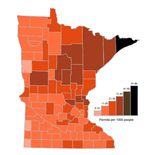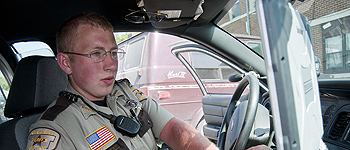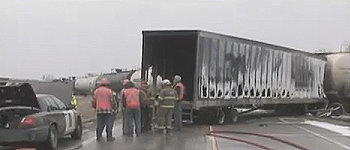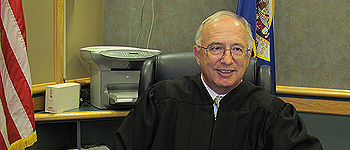Ground Level
- Home
- Features
- Disbanded Police
- Explore the Data
- from the Blog
- TPT Videos
- About Us
Although rural crime rates are lower than those in urban areas, public safety takes a big share of local government budgets outstate. So it has come under scrutiny in a time of fiscal restraint. At the same time, in areas where populations are dwindling and aging, security concerns can change. Telecommunications, surveillance and other technology are changing how law enforcement deals with safety. And for some, what is needed is a greater sense of personal responsibility when it comes to their safety.
This special Ground Level news report explores how new approaches to old problems are offering both hope and new dilemmas.
Ground Level Features
Rural crime characteristics
Rural domestic violence: Dangerous for victims, complicated for police
MPR's The Daily Circuit takes a closer look at rural domestic violence; taking a closer look at the way domestic violence plays out in rural communities.
Rural crime Q and A
We asked Ralph A. Weisheit, a criminal justice professor at Illinois State University, and Joseph F. Donnermeyer, professor of rural sociology at Ohio State University, about rural crime and what is unique about it.
Ground Level Video
Guard Llamas in Park Rapids
Police Drone Discussion
Examine the data
Why does Minnesota's handgun permit map look like this?

The concentration of handgun permits is much higher in northeastern Minnesota than in southwestern Minnesota, a distribution pattern common to many phenomena in the state. Why is that?

Exploring the Price of Safety
 Budget crunch forces cities and counties to rethink policing
Budget crunch forces cities and counties to rethink policing
Aug 13, 2012
Bird Island is home to just over 1,000 people. To save tax dollars, it disbanded its full-time police department at the end of June and now contracts for law enforcement with the sheriff's office.
 Shoestring collaboration with dreams of robots
Shoestring collaboration with dreams of robots
Aug 13, 2012
Making do is a recurrent theme for the team of 16 officers, deputies, sheriffs and chiefs from a range of western Minnesota law enforcement agencies making up the West Central S.W.A.T.
 Unique court lets tribal and state judges fight addiction together
Unique court lets tribal and state judges fight addiction together
Aug 13, 2012
The Leech Lake Band of Ojibwe has joined with two northern Minnesota counties to create a "wellness court" that for the first time is letting tribal and district court judges act together to handle addiction and substance abuse.
 Town saves money on cops, wonders if it did right
Town saves money on cops, wonders if it did right
Aug 13, 2012
Like an increasing number of Minnesota towns, Fertile relies on the county sheriff for law enforcement. Some residents worry more about safety.
 Combined response to a hazardous waste spill in the middle of the night
Combined response to a hazardous waste spill in the middle of the night
Aug 13, 2012
A situation tailor made to overwhelm the emergency services of a small town turned into a model of local, state and even federal cooperation. Sometimes Homeland Security money does more than fight terrorism.
 Video expands Duluth police force
Video expands Duluth police force
Aug 13, 2012
Their budget under pressure, Duluth police have turned to video camera surveillance to fight crime. They say it works. But they aren't cheap.
 In sparsely-populated districts, TV hearings save money
In sparsely-populated districts, TV hearings save money
Aug 13, 2012
District Judge Jerry Seibel rides a circuit to preside over cases throughout western Minnesota. Increasingly, that means turning on the TV and manning a remote control.
 Police see drones as cheap eye in the sky
Police see drones as cheap eye in the sky
Aug 13, 2012
Many law enforcement officials think airborne drones can make life safer, but the technology scares some.
 Rural security firm stands guard over empty farms and cabins
Rural security firm stands guard over empty farms and cabins
Aug 13, 2012
One Minnesota business is experiencing a boom because more farms stand empty and farmers feel the need to provide their own security.
Disbanded Police Departments
Twenty Rural Police Departments have been disbanded since 2007
Every year, at least several Minnesota towns disband their police departments, typically in an effort to save money. Most contract with the county sheriff's department for law enforcement.

Brooten
- Population: 743
- Disbanded in 2007
- Replacement: Contract with City of Belgrade Police
Clarissa
- Population: 681
- Disbanded in 2007
- Replacement: Contract with Todd County Sheriff
Marble
- Population: 701
- Disbanded in 2007
- Replacement: Contract with Itasca County Sheriff
Stewart
- Population: 571
- Disbanded in 2007
- Replacement: Contract with McLeod County Sheriff
Cass Lake
- Population: 770
- Disbanded in 2008
- Replacement: Contract with Cass County Sheriff
McIntosh
- Population: 625
- Disbanded in 2008
- Replacement: No Contract, coverage by Polk County Sheriff
Biwabik
- Population: 969
- Disbanded in 2009
- Replacement: Contract with City of Gilbert Police Department
Browns Valley
- Population: 589
- Disbanded in 2009
- Replacement: Contract Traverse County Sheriff Office
Cook
- Population: 574
- Disbanded in 2009
- Replacement: No contract, coverage by St. Louis County Sheriff
Erskine
- Population: 503
- Disbanded in 2009
- Replacement: No contract, Coverage by Polk County Sheriff
Hackensack
- Population: 313
- Disbanded in 2009
- Replacement: No contract, Coverage by Cass County Sheriff
Watkins
- Population: 962
- Disbanded in 2009
- Replacement: Contract with Meeker County Sherriff Office
Biwabik Township
- Population: 804
- Disbanded in 2009
- Replacement: No contract, Coverage by St. Louis County Sheriff
Nevis
- Population: 390
- Disbanded in 2009
- Replacement: Contract with Hubbard County Sheriff
Mora
- Population: 3571
- Disbanded in 2010
- Replacement: Contract with Kanabec County Sheriff Office
Hendricks
- Population: 713
- Disbanded in 2011
- Replacement: Contract with Lincoln County Sheriff
Jackson
- Population: 3299
- Disbanded in 2011
- Replacement: Contract with Jackson County Sheriff Office
Balaton
- Population: 643
- Disbanded in 2012
- Replacement: Contract with Lyon County Sheriff
Madison
- Population: 1551
- Disbanded in 2012
- Replacement: Contract with Lac qui Parle County Sheriff
Bird Island
- Population: 1042
- Disbanded in 2012
- Replacement: Contract with Renville County Sheriff

Numbers tell a story of crime and spending
Local law enforcement spending declines.
After years of growth, many cities and counties have started to shrink their spending on police and sheriff services, after inflation is taken into account. The most recent data collected by the Minnesota state auditor is for 2010 but law enforcement officials say 2011 and 2012 spending levels were flat or down. Sheriffs in dark blue counties spent less in 2010 than the year before when spending is adjusted for inflation.
Source: Minnesota State Auditor
Sheriff and police spending peaks in 2009
After rising for many years, sheriff spending and city police spending outside Minneapolis and St. Paul dropped in 2010, the latest year figures are available. Law enforcement officials say the number is likely to remain flat or drop further when 2011 and 2012 are tallied.
Source: Minnesota State Auditor
Minnesota handgun permits rise steadily
The number of valid permits that Minnesota sheriffs issue to allow people to carry handguns has risen steadily since the state's permit-to-carry law passed in 2005. More than 90,000 permits were in effect at the end of 2011. See the next tab to see the geographic distribution.
Source: Minnesota Bureau of Criminal Apprehension
Northeastern Minnesotans most likely to have handgun permits
The number of Minnesotans holding valid handgun permits has been rising steadily. On a per capita basis, counties in the northeastern part of the state tend to have the highest number of permits and counties in the southwest the lowest. Information is based on the valid permits in effect as of Dec. 31, 2011.
Source: Minnesota Bureau of Criminal Apprehension
Rural crime lower but gap shrinks
Rates for violent crime are substantially higher in urban areas but they have been falling while rural crime rates have remained pretty flat. Rural crimes are defined as those reported by county sheriffs.
Source: FBI: Uniform Crime Reports as compiled by Ralph Weisheit, Illinois State University
Minnesota rural crime is down
In Minnesota, overall crime reported to sheriffs has fallen in the past few years for which data are available. But people's perceptions don't always match. See next tab.
Source: Minnesota Bureau of Criminal Apprehension Part I Offenses reflect information on eight "serious" crime classifications, and it is generally referred to as the "Crime Index" measurement. Part II Offenses are represented by twenty "less serious" crime classifications. Full FBI list of Part 1 and 2 crimes.
Gallup: More people think crime is getting worse
Gallup regularly asks poll respondents "Is there more crime in your area than there was a year ago, or less?" For more than a decade, people have increasingly tended to say crime in their area is increasing.
Source: Gallup
Redesigning MN: Margin of Safety -- A Twin Cities Public Television broadcast
Like MPR News’ Ground Level project, Twin Cities Public Television is looking at how state, county and local governments are adapting one of the most important services they deliver—public safety. The TPT effort is part of a two-year-long project called Redesigning MN.
Here are video clips of two of the stories that are part of a new hour-long documentary called “Margin of Safety.”
You can see the broadcast at 8 p.m. Friday Aug. 17 on TPT Channel 2.1., it will also be rebroadcast at 8 p.m. Sunday Aug. 19 on TPT MN Channel 2.2.
Click to show the complete broadcast schedule.
For more information go to www.redesigningmn.org
Redesigning MN: Margin of Safety: Inmate Transportation Pilot Project
Redesigning MN: Margin of Safety: Hennepin County Juvenile Justice Reform
Ground Level: a Minnesota Public Radio News project examining community issues across Minnesota
We identify topics that are significant and complex and that play out uniquely at the local level. We want to explore those issues in which people taking action in their communities make a difference and can serve as guides for others.
Ground Level launched in early 2010 and shines a light on a variety of topics, from the growing complexity of Minnesota's local food system to cities preparing for new fiscal realities, from exurban growth in Baldwin Township to the quest to expand broadband access across the state.
We experiment with coverage on a variety of platforms. This includes text, audio and video online, of course - the Ground Level blog, a series of topics pages and social networking, for example. It also includes on-air coverage, public forums both virtual and real-world and collaboration with community-based media.
Our audience consists of Minnesotans interested in community life, particularly those who are taking an active part in it or helping others do the same.
Ground Level is very much an experiment -- in finding ways to learn about and tell stories, in working with other organizations, in walking up to the line between providing insight and advocating specific actions. Our goal is to inform and give people the ability and incentive to engage with their community. We invite your feedback and your ideas, via the blog, twitter at @MPRGroundLevel, phone calls, emails, whatever. Join us.
About the team:

Dave Peters
Dave Peters directs MPR's project on community journalism, looking for ways Minnesota residents are making their towns, cities and neighborhoods better places to live. He joined MPR News in 2009 after more than 30 years as a newspaper and online reporter and editor. Contact Dave

In The Spotlight
-
The Current Music Blog
Your daily note for good music, news and pop culture. With attempted jokes.
Support for Ground Level is provided
by the Bush Foundation.













